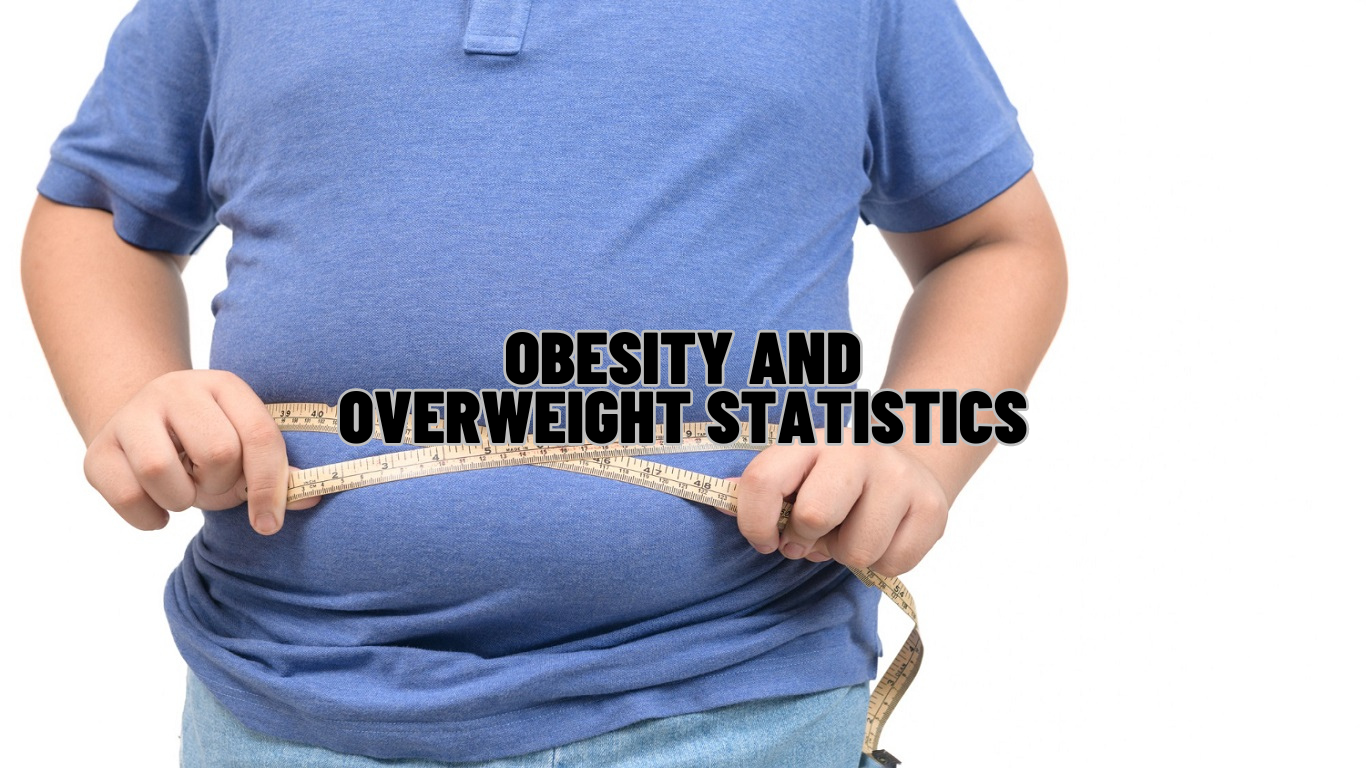This article is based on scientific evidence, written by experts and fact-checked by experts.

Obesity is a chronic and relapsing condition caused by multiple factors like genetics, environment, social inclusion, mental health, economic development, diet, and healthcare access. It is also a significant risk factor for various non-communicable diseases(NCDs) like diabetes, cancer, and heart ailments.
As the global obesity rate has risen by 2% every decade since 1975 and doubled since 1980, many organizations like the American Medical Association recognize obesity as a disease.
In this article, we have covered critical statistics on obesity. These figures give valuable insights into obesity prevalence in different periods, genders, age groups, and ethnicities, particularly in the US. We have also included future predictions on obesity and some assorted stats.
General Obesity And Overweight Statistics

These numbers give you a high-level view of the change in the obesity rate and its economic impact since 1988. We also walk you through crucial stats on the WIC(Women Infant Children) federal program encouraging nutrition cum healthy eating for infants, children below 5 years, and pregnant, lactating, or postpartum women from the low-income bracket.
- The percentage of obese adults in the U.S. increased from 22.9% to 42.4%.
- The share of severely obese people increased from 2.8% to 9.2%.
- The percentage of obese and overweight women rose from 25.9% to 41.9% and 27.5%, respectively.
- The proportion of overweight men fell from 40.7% to 34.1%, while that of obese males increased from 20.2% to 43%.
- The obesity prevalence among children (6-11 years) and adolescents(12-19 years) touched 19.3% and 20.9%, respectively.
- 30.7% of adults are overweight.
- 16.1% of children aged 2-19 are overweight.
- 19.3% of children and adolescents are obese.
- 6.1% of kids suffer from severe obesity.
- 12.3% of WIC-enrolled infants aged 3-23 months had a high weight-to-length.
- Infant obesity prevalence was the highest among American Indian & Alaska natives(15.8%) and lowest among Pacific Islanders(8.8%).
- The childhood obesity rate was the highest among Alaska Natives(18.4%), followed by Hispanics(17.4%), non-Hispanic Whites(12.3%), non-Hispanic Blacks(11.9%), and Asian or Pacific Islanders(10.7%).
- 14.4% of the participants aged 2-4 were obese.
- Obesity prevalence among 2-4-year-olds was between 8.3%-19.9%.
- The obesity rate among kids aged 2-4 decreased by over 3% in 7 US territories – the Commonwealth of the Northern Mariana Islands, Utah, New Mexico, New Jersey, Nevada, Puerto Rico, and Virginia.
- It rose in American Samoa (2.4%), Delaware(1.4%), Hawaii(1.3%), North Carolina(0.9%), North Dakota(1.8%), Washington(0.5%), and West Virginia(2.1%).
- The obesity and overweight prevalence rate plummeted from 32.5% to 29.8% during 2010-2020.
Location Based Obesity And Overweight Statistics
Below are vital obesity stats from specific regions of the world:
- In 2016, obesity rates in South East Asia and Western Pacific regions rose by 4.7% and 6.4%, respectively.
- Among ASEAN countries, Malaysia had the highest obesity prevalence rate(15%) in 2021.
- 19 U.S. states had an obesity rate of over 35%.
- Among U.S. states, West Virginia has the highest percentage of the obese population – around 41%, followed by Louisiana(40.1%) and Oklahoma(40%).
- The district of Columbia has the lowest percentage of obese population – nearly 24.3%, followed by Colorado(25%) and Hawaii(25.9%).
- In 2022, 60% of Finland’s population and 58% of Icelandians were overweight.
- 55% of adults in Mexico stated obesity is the biggest health issue in the country.
- In Saudi Arabia, the National Diet and Physical Activity strategy was formulated to reduce obesity by 40%.
Gender-based Obesity And OverweightStats
These statistics delve deeper into the gender-wise distribution or prevalence of obesity across America.
- 6.9% of men and 11.5% of women were severely obese during 2017-2018 in the U.S.
- 32% of adults – 14% of men and 18% of women – were obese worldwide in 2020.
- Obesity prevalence among both men(33.1%)and women(33.9%) is the highest in the U.S. Ireland has the second-highest male obese population(26%), while Chile has the second-highest female obese population (28.6%).
- Central obesity in American men and women was 50.1% and 72.5%, respectively, in 2020.
Age Based Obesity And OverweightStatistics
According to recent data from the World Health Organization, over 1 billion people worldwide are obese – 39 million children, 340 million adolescents, and 650 million adults. In this section, we have presented stats that show an age-wise breakup of obesity prevalence in the US.
- In 2016, age-standardized obesity prevalence among U.S. adults was 36.2%; it was 21.4% among 5-19-year-olds.
- According to a 2020 study, 32% of Americans aged over 18 are obese.
- In 2021, 29.5% of U.S. adults aged above 65 were obese – a 2.8% increase from 2013.
- In 2022, 37 million children aged below 5 were overweight.
- The prevalence of overweight in American kids aged below 5 was 7.9%
- Adults aged 18-24 (20.5%) recorded a lower obesity prevalence rate than those aged 45-54(39.9%).
- Obesity prevalence in US adults aged over 60 is 41.5%; it is 44.3% in people aged 40-59 and 39.8% among those aged 20 – 39.
- The obesity rate was the lowest among individuals between 2-19 years in the highest income group – around 10.9%, followed by those from the middle-income bracket (19.9%) and the lowest income category (18.9%).
- The obesity occurrence rate was 22.2% among children aged 12-19, 20.7% among those aged 6-11, and 12.7% among 2-5-year-olds.
- Among children between 10 – 17 years, West Virginia had the highest obesity rate of 26%, followed by Kentucky(25.5%) and Louisiana(24%).
- Obesity and weight problems in children resulted from malnutrition in 16 countries.
Ethnicity Based Obesity And Overweight Stats
Below, we have compiled essential statistics from various sources like Statista and CDC That give an idea about the ethnic profile of the obese population in the U.S.
Impacts Of Obesity On Health

Obesity increases vulnerability to NCDs and many other fatal conditions. The following stats effectively capture the adverse effects of obesity on human health.
- Obesity is the prime cause of 25% of stillbirths between 37-42-week gestation.
- As per a 2013 study, 14% of the 212 participants diagnosed with pre-eclampsia had higher BMIs.
- People with higher waist-to-height ratios have a 71% greater risk of cancer.
- The relative risk of developing colorectal cancer due to obesity is 1.3.
- Between 2017-20, diabetes prevalence among obese American adult males was 24%.
Future Forecasts
According to the World Obesity Atlas 2022, 14.28% of men and 20% of women worldwide will be obese by 2030. Numerous studies have stated that by 2035:
- The percentage of overweight individuals worldwide is expected to become 51%.
- The proportion of obese people alone may rise up to 24%.
- Over 4 billion of the world’s population may be overweight or obese.
- The economic impact of obesity on the GDP of high-income, upper-middle, lower-middle, and low-income countries will likely rise to 3%, 3.1%, 2.1%, and 1.1%, respectively.
- The economic impact of obesity on the Americas alone will likely cross $1.47 trillion.
- The obesity rate among men and women may reach 23% and 27%, respectively.
Stats On Weight-Loss Methods

The following statistics present an overview of prime techniques adopted by people to shred excess pounds.
Parting Thoughts!
81% of obese people think lack of willpower and affordable unhealthy foods are the prime barriers to weight loss. According to an April-May 2020 online survey, more than 33.33% of adult obese participants gained weight during the COVID-19 pandemic due to pandemic-induced anxiety, stress eating, snacking, lack of physical activity, and increased alcohol intake.
While the above stats clearly indicate that obesity can’t be treated overnight, exercising, reducing the consumption of high-calorie, carb-rich, or fatty foods, and intermittent fasting help curtail weight naturally.



